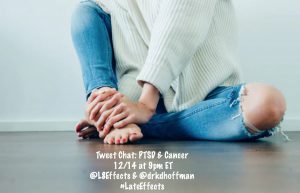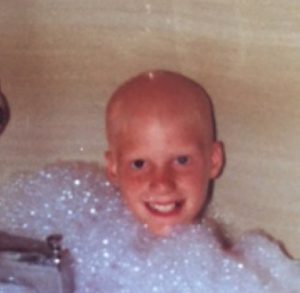“I think all too often we underestimate the impact of a cancer diagnosis on the mental health and well-being of the individual, thus it goes unaddressed.” ~Stephanie Zimmerman, MSN
 Research indicates that, for some people, these symptoms of anxiety might actually be post-traumatic stress disorder or PTSD.
Research indicates that, for some people, these symptoms of anxiety might actually be post-traumatic stress disorder or PTSD.PTSD is a response to witnessing or experiencing a traumatic, life threatening event, like combat or an auto accident. But more and more research indicates that a cancer diagnosis can cause PTSD, not only in patients but in the case of childhood cancer, caregivers like parents of those who have had childhood cancer. PTSD symptoms can include: nightmares, frightening thoughts, persistent feelings of fear, avoidance behaviors and flashbacks.
Research on PTSD and Cancer
In one study, researchers interviewed over 1000 women who had recently been diagnosed with breast cancer. The study included two follow-up interviews at four months and again at six months. The interviews measured traumatic stress. This study found that almost one-fourth of the women had PTSD symptoms during their first interview. Of those, 12% showed persistent PTSD symptoms over the follow-up interviews. Moreover, almost seven percent of those who didn’t have symptoms in the first interview, developed PTSD by the month four follow-up interview. PTSD was associated with being younger at the age of diagnosis and being black or asian.
Another recent study conducted in Germany assessed acute and post traumatic stress disorders in women diagnosed with breast cancer before treatment, after treatment and one year after diagnosis. Eighty-two percent of the women had symptoms of PTSD although they would not be diagnosed with full PTSD. Only 4% of the group were diagnosed with full PTSD.
 Childhood cancer survivors are also at risk for PTSD. In a study of 182 childhood cancer survivors over 5 years from diagnosis and over 2 years out of treatment, 16% had PTSD. Another study looked at parents of childhood cancer survivors. Almost 14% of the mothers had the diagnostic criteria of PTSD and 20% of the families had at least one parent with PTSD.
Childhood cancer survivors are also at risk for PTSD. In a study of 182 childhood cancer survivors over 5 years from diagnosis and over 2 years out of treatment, 16% had PTSD. Another study looked at parents of childhood cancer survivors. Almost 14% of the mothers had the diagnostic criteria of PTSD and 20% of the families had at least one parent with PTSD.
Evaluating for PTSD
Below is a PTSD checklist (civilian version). Researchers have compared the results obtained from patients taking the PTSD checklist (civilian version) with an 82-item Impact of Cancer Scale and have determined that it is an effective measure.
This is a self-administered checklist. You indicate the degree to which you have been bothered by the symptom.
“Instruction to patient: Below is a list of problems and complaints that veterans sometimes have in response to stressful life experiences. Please read each one carefully, put an “X” in the box to indicate how much you have been bothered by that problem in the last month.”
“There are 2 ways to score this checklist. 1) Add up all items for a total severity score or 2) Treat response categories 3–5 (Moderately or above) as symptomatic and responses 1–2 (below Moderately) as non-symptomatic, then use the following DSM criteria for a diagnosis: – Symptomatic response to at least 1 “B” item (Questions 1–5), – Symptomatic response to at least 3 “C” items (Questions 6–12), and – Symptomatic response to at least 2 “D” items (Questions 13–17) ~https://www.mirecc.va.gov/docs/visn6/3_PTSD_CheckList_and_Scoring.pdf“
PTSD and Cancer Tweet Chat
This Thursday December 14, Stephanie Zimmerman @L8Effects and I @drkdhoffman will be hosts to a tweet chat on Twitter at 9 pm. To participate in the chat, you must have a Twitter account. Go to http://tweetchat.com/ and enter the hashtag #LateEffects. We’ll see you in our chat room at 9pm ET 8pm CT or 6pm PT.








People suffering thru a traumatic event, like having cancer, are not suffering from Post Traumatic Stress Disorder. They are suffering from the stress of the event. PTSD is defined as experiencing a traumatic event and then returning to a normal stress level. At a later date,symptoms of stress reappear, hence the term PTSD. People do not generally associate the new stress with the prior event or if the stress reappears gradually they may not even realize what is happening. Also, a second traumatic event,like having cancer, may trigger stress from a prior event.
Thank you for your thoughtful comment. Best, Kathleen
But what if the symptoms of ptsd appear after the illness, when the people are healthy again? For me, everything was okay for almost two years but then I started getting many symptoms of ptsd. Is it possible to get ptsd when you’ve actually been healthy for some time?
I believe that PTSD is a given when a cancer diagnosis is received. I have lived through a brain tumor diagnosis 10 years ago, and then out of the blue a Chronic Myeloid Leukemia diagnosis in February 2019. I experience symptoms of PTSD every day. Thank you for this information x